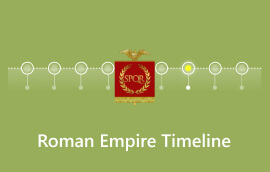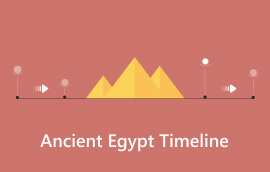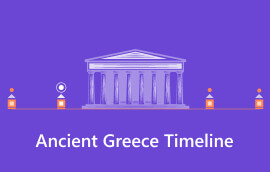Journey Through Time: An Ancient Civilization Timeline
Even in modern times, there are still people who are into history. They see it as a time machine that can take them through the past. Thus, ancient history is no exception. As historians continue their study, they also become interested in its civilization timeline. If you are also in that same situation, you are on the right track. The goal of this post is to walk you through the ancient civilization timeline. Moreover, we will introduce a tool that can help you create a comprehensive timeline.

- Part 1. Ancient Civilizations Timeline
- Part 2. Introduction to the Major Ancient Civilizations
- Part 3. FAQs About Ancient Civilizations Timeline
Part 1. Ancient Civilizations Timeline
Are you looking for an ancient civilization timeline chart? Well, we can provide the diagram that you need. At the same time, ensure you will be able to grasp everything you need to know about it. Ancient civilization is an important part of our history. Thus, it is also vital to understand it first. Let us define and discuss it below.
The concept of civilization represents the stage of advancement. It is also where people coexist within organized communities. Thus, the ancient civilization refers to the initial settled and stable communities. These societies laid the basis for later states, nations, and empires. The study of it focused on the earliest phases within the broader domain of ancient history. The era of ancient history started around 3100 BC and extended for over 35 centuries.
Now that you have an idea about the ancient civilization take a look at its timeline below. The visual presentation timeline aims to help you view them in an organized manner. Not only that, but to guide you step-by-step in your study of ancient civilization.

Get a detailed ancient civilization timeline.
Bonus: Best Timeline Maker
As you see in the diagram above, it is better to use a timeline to display and view the essential information. Yet, creating a timeline wouldn't be possible without using the right tool. There are several programs you may find over the internet, but MindOnMap will be your best option. It is a bit challenging to make a timeline diagram, especially if you are a first-timer. Taking that into consideration, MindOnMap made sure that the tool is easy to use. But it also offers professional ways to make your diagram creative.
Now, MindOnMap is a web-based program that lets you create a timeline according to your needs. It allows you to draw your ideas in as organized and presentable a way as possible. Also, it offers plenty of editing tools to assist you in creating a more personalized diagram. Depending on your preferences, you may select the template you need. It provides a tree diagram, organizational chart, flowchart templates, and so on. You can also add icons, texts, shapes, etc., to add more flavor to your diagram. Another thing, you may insert links and pictures too! Furthermore, it has an auto-saving feature, allowing you to save whatever you’re working on in the tool. At the same time, collaborating with your peers or colleagues is also possible with it.
So, creating a timeline of ancient civilizations on MindOnMap is much easier. You can access the tool on various popular browsers, like Google Chrome, Safari, Edge, and more. In fact, it can now download its app version to your computer. Today, start creating a timeline of your own with this program.
Secure Download
Secure Download

Part 2. Major Ancient Civilizations Overview
Long ago, in different parts of the world, some amazing people lived together. Also, they built incredible things. These groups are what we call ancient civilizations. They each had their own unique ways of life, languages, and cultures. Let's explore the 4 ancient civilizations timeline and its ove:
Ancient Mesopotamia (3500 – 1900 BCE)
In ancient Mesopotamia, the world's oldest city civilization began. It is a place where people first started to build cities and create written languages. Its place is in the region between two rivers, the Tigris and the Euphrates. These rivers provide water for farming. Thus, the people there developed some of the earliest forms of writing, like cuneiform. They also built towering ziggurats and had laws, like the Code of Hammurabi.
Ancient Civilizations of Africa (3100 – 332 BCE)
In Africa, there were many ancient civilizations, each with its own rich history. Egypt united around 3100 BCE after a southern king conquered the north. They became the top power for centuries, building big temples. But there were also other great civilizations like the Kingdom of Kush and the Mali Empire. They thrived on the gold and ivory trade. Then, followed Egyptian beliefs, with many pyramids. The Kingdom of Axum in Ethiopia adopted Christianity early and lasted for centuries. These societies flourished through agriculture, trade, and cultural achievements.
Ancient European Civilizations (3000 – 750 BCE)
Europe has a long history filled with fascinating ancient civilizations. Ancient European civilizations began in Greece with the Minoans around 3000 BCE. They wrote, built cities, and were artists. The Mycenaeans came around 1900 BCE, and the Minoans, with trade spanning Egypt, Italy, and more. These civilizations declined around 1100 BCE. And their stories became legends for the Greeks. On the Italian peninsula, Etruscans rose around 750 BCE. They flourished until the Romans absorbed them. The Roman Empire was another influential civilization. It has its mighty legions and advanced engineering. These cultures have left a lasting impact on modern Europe.
Asia Civilization (3300 BCE - Present)
Asia was home to some of the world's oldest civilizations. China's ancient history and dynasties are popular for their inventions. It includes paper and gunpowder. India had the powerful Indus Valley Civilization. Later, the Gupta Empire made significant advances in mathematics and astronomy.
So that completes our ancient civilization timeline.
Further Reading
Part 3. FAQs About Ancient Civilizations Timeline
What is the oldest civilization in the world timeline?
The Sumerians are often considered one of the oldest civilizations in the world. Their civilization dates back to around 3500 BCE in Mesopotamia (modern-day Iraq).
When did ancient civilization start and end?
Ancient civilizations began to emerge around 3500 BCE with cultures like the Sumerians. The end of ancient civilization is often marked in 476 CE during the fall of the Western Roman Empire.
Who is older, ancient Greek or ancient Roman?
The ancient Greek civilization is generally considered older than the ancient Roman civilization. The ancient Greeks began to develop around the 8th century BCE. The Roman civilization dates its legendary founding to 753 BCE.
Conclusion
To wrap it up, knowing about the ancient civilizations timeline is fulfilling. These civilizations serve as a reminder of our own history. Also, being able to present them in a creative manner makes it more satisfying. To experience that satisfaction, we all need an appropriate tool. In that case, MindOnMap is the best example. Everything you need, like templates, editing features, etc., are all in one tool. What’s more, with its intuitive interface, whether you're a pro or beginner, you can definitely use it.










